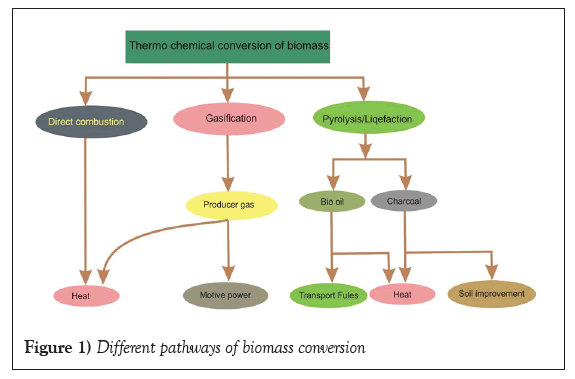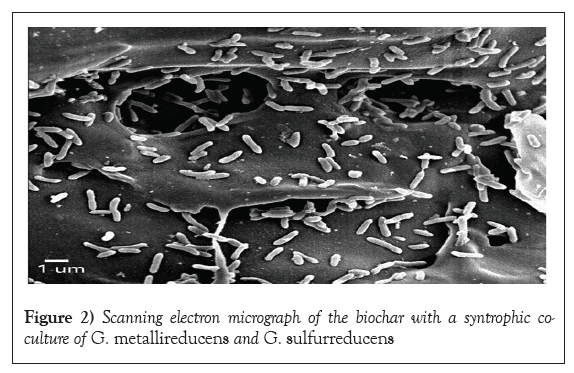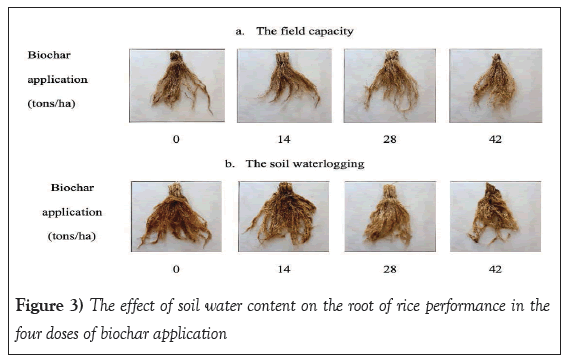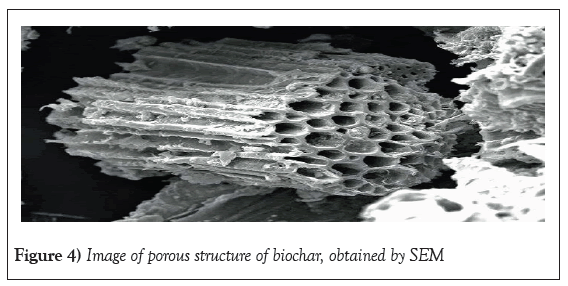Agricultural and Biological Research
RNI # 24/103/2012-R1
Research Article - (2024) Volume 40, Issue 1
A solid, black, C-rich byproduct of the pyrolysis of biomass is called biochar. Biochar has long been recognized as a soil C sequester, but it has also recently been promoted for use in agricultural applications to improve soil quality; for this reason, its agronomic value is assessed. One of the main effects of intensifying agriculture is that ecosystem carbon reserves are reduced as a result of the release of carbon (C) into the atmosphere as carbon dioxide (CO2). Ten to twelve percent of the world's anthropogenic greenhouse gas emissions come from agriculture. Reducing greenhouse gas emissions is necessary to address the difficulties posed by climate change. The process of pyrolysis, which turns biomass into biochar and stabilizes the carbon (C), is used to reduce elevated amounts of CO2 in the atmosphere. The process of pyrolysis, which turns biomass into biochar, reduces atmospheric CO2 levels by stabilizing the carbon (C) that is subsequently added to soil. Biochar has a high carbon content that can be difficult for it to break down, which means that it could stabilize carbon sequestration. While some research indicated that adding sulfur to mercury-polluted soil decreased the amount of mercury (Hg) that plants absorbed, other studies found that lowering the pH increased the solubility of heavy metals. As a result, the impact of sulfur on the availability of heavy metals in the soil is unclear and requires further investigation. Numerous recent research has demonstrated the effectiveness of biochar in lowering the uptake of heavy metals by plants.
Soil microbial population; Gasification; Dissolved organic matter; Biochar
The ability of a soil to provide plant nutrients in the right amounts to support agricultural yield is known as soil fertility. Due to the imbalance of the abiotic and biotic soil fertility variables caused by current agricultural practices, which have a negative environmental impact, agro ecosystems frequently experience degradation of soil fertility and depletion of available nutrients [1-4]. Biochar is a stable, anthropogenic product rich in carbon that is produced through the thermal breakdown of biomass at temperatures below 700°C, when there is little to no accessible oxygen [5]. Compared to other organic amendments, biochar has much higher soil stability [6]. Because of its special qualities, biochar can improve the physical, chemical, and biological characteristics of soil; applying biochar increases the soil's overall fertility [7]. Plant growth has been demonstrated to increase when biochar is applied to soil; however, the effects varied depending on the type and quantity of biochar used. Lehmann and Rondon [8] found that applying various biochars at varying rates significantly increased plant productivity. According to reports, biochar can significantly impact the microbially mediated transformation of nutrients by either inducing soil alkalization or interacting on the surface with substrate and soil microbial enzymes.
By adjusting soil characteristics such as soil porosity, soil aggregation, soil reaction (pH), and soil organic carbon, the application of biochar can increase soil fertility. As a result, the soil becomes safe and nutrient-rich for supporting plant growth. Furthermore, the application of biochar boosts the population and activity of rhizobia species in the soil. In agricultural fields, the application of biochar reduced greenhouse gas emissions. Soil contaminants efficiently adsorbed, inhibited biodegradation, and prevented contaminants from leaching into ground water [9].
Biochar's high porosity allows it to hold onto a lot of water, which helps increase the soil's ability to hold water when applied to sandy soils [10]. In pot trials of lettuce (Lactuca sativa L.) and cabbage (Brassica oleracea L.) that used sandy, acidic soils in Cambodia, application of rice husk biochar at rates ranging from 50-150 g kg-1 demonstrated beneficial effects by increasing the final biomass, root biomass, plant height, and number of leaves in all the cropping cycles when compared to the control [11]. Moreover, the non-fertilized soil with a 50 g kg-1 biochar addition showed the largest biomass increases for lettuce (903%) and cabbage (750%) [11]. Application of biochar amendments has the potential to enhance the fertility status and quality of agricultural soils in the Midwest [12]. Additionally, they have reported that the majority of the plant micronutrients, Ca, Mg, K and P, as well as roughly half of the N and S in the biomass feedstock, are partitioned into the biochar fraction; as a result, the majority of nutrients can be returned to the soil. Furthermore, agricultural soils in the Midwest, the addition of soil biochar can both decrease nutrient leaching and have the ability to absorb Dissolved Organic C (DOC) from the soil solution [12]. Therefore, biochar's capacity to lessen N mineralization and NO3-N leaching is crucial for determining management options in agricultural production. Adding charcoal to mineral-fertilized banana and organically-fertilized guarana (Paullinia cupana Kunth) plantations can improve soil pH, total N, available Na, Zn, Mn, and Cu as well as soil humidity [13]. However, it can only reduce acidity and Al availability in inorganically fertilized plantations. Adding biochar to soils that are managed conventionally or organically improved moisture retention and decreased bulk density [14].
By altering the chemical and structural makeup of soil, biochar has a substantial impact on soil quality. It can be applied to bioremediation and water stress management, especially in the recovery of soils contaminated with heavy metals and PAHs [15]. An increasing amount of research is demonstrating the beneficial effects of biochar on plant growth and development; nevertheless, the type of soil and climate have a significant influence on these effects. Additionally, it appears that applying biochar in addition to mineral or organic fertilizers greatly increases the plant's efficiency in using fertilizers. Ultimately, it was discovered that biochar significantly altered the structure and function of the soil microbiota, suggesting that it may foster an environment that is conducive to microorganism growth. A cheap and effective weapon in the fight against climate change is biochar. Decomposition of organic materials releases greenhouse gases into the atmosphere, including carbon dioxide and methane, which has a potency of 21 times greater than that of CO2 [16]. According to estimates, using this technique to "tie up" carbon could result in a 10% reduction in the world's current carbon emissions. Adding biochar to soil improves its fertility, affects carbon sequestration, and lowers methane and nitrogen oxide emissions from soil surfaces that come from the soil's natural putrefaction processes [17]. With a far greater greenhouse potential than CO2, methane and N2O are both categorized as dangerous greenhouse gases. Because of its extremely porous structure, biochar is a very useful soil amendment. Fertility is increased because it promotes microbial growth. Furthermore, biochar's high porosity and high specific surface area enhance soils' ability to retain water [18]. Sulfur and biochar can be used independently to treat Ni2C-contaminated soils [19]. This can be done by either using sulfur to increase the availability of Ni2C for the hyper-accumulator plant to readily absorb it or by using biochar to adsorb the Ni2C. This approach supports sustainable agriculture. While CO2 has a lower greenhouse potential than methane and N2O, they are both categorized as harmful greenhouse gases. Because of its extremely porous structure, biochar can be used as a soil amendment fairly easily. Fertility is improved because it promotes microbial development. Biochar's high porosity and specific surface area enhance soil’s ability to retain water [18]. Sulfur and biochar could be applied separately to remediate Ni2C-contaminated soils in two ways: either by increasing the availability of Ni2C so that the hyper-accumulator plant can readily absorb it, or by adsorbing it through the use of biochar [19]. This would support sustainable agriculture.
Method of biochar production
Heating organic material in an oxygen-starved or oxygen-free environment can produce biochar [20]. This outcome can be attained in a variety of methods. The relative quality of biochar as a soil amendment is significantly influenced by the kind of organic matter (or feedstock) utilized and the production conditions [21]. Depending on what is used to prepare it and how it is finished, biochar's characteristics can vary greatly. Certain types of biochar may possess qualities that make them a great addition to a particular soil, but not to another, or they may just be terrible (Figure 1) [22].

Figure 1: Different pathways of biomass conversion.
Impact of biochar on soil biology
Earthworms and biochar both have beneficial effects on soil types in a greenhouse. The availability of mineral nutrients is increased by earthworms and biochar, indicating that this mechanism has been crucial. The primary distinction between earthworms and biochar in terms of their effects on plant metabolism is that the former cause the indirect release of plant growth factors, while the latter also affects soil microbial communities and encourages the activity of microorganisms [23]. The functioning of soils depends on the soil biota, which also offers numerous vital ecosystem services (Figure 2) [24].

Figure 2: Scanning electron micrograph of the biochar with a syntrophic coculture of G. metallireducens and G. sulfurreducens.
Soil rich in black carbon may have even higher microbial populations. For this reason, the interaction between biochar and other soil amendments is essential for the health of the soil biota [25]. Moreover, following biochar additions, a shift in the makeup of the soil microbial community and an increase in soil microbial biomass were noted [26]. The biochar's pores and backbone, which are influenced by biological processes, allow microorganisms to proliferate [27]. According to Joseph et al., [28], the majority of biochar has a high concentration of interior macropores that reach from the surface, where minerals and tiny organic particles may collect. Adsorption strength of high surface area (Specific Surface Area; SSA) biochars is typically much greater than that of low SSA biochars, making them particularly difficult to control pests [29-31]. One element that might have an impact on the microbial community is the pyrolysis temperature during the biochar production process [32]. They discovered a relationship between low temperature pyrolysis biochar and Gram-negative bacteria. Additionally, it was reported that all forms of biochar, with the exception of that made at 700°C, had increases in Gram-positive bacteria and a high abundance of gram-negative bacteria in a low 350°C biochar treatment. The population of rhizobia linked to chickpeas was higher in soil that had been amended with biochar because biochar is an appropriate carrier of microbes [33]. Applying biochar together with Azospirillum greatly increased the number of diazotrophic microorganisms and Azospirillum in the rhizosphere [34].
Impact of biochar on crop production
For spring barley (Hordeum vulgare cv. Anakin) grown on soil columns prepared with sandy sub-soils, the incorporation of 1% straw biochar increased root penetration, root density (54%) and grain yield (22%) [35]. In South Sumatra, Indonesia, applying charcoal amendments from Acacia mangium bark at a rate of 10 mg ha-1 enhanced maize yield by about 50% when fertilized with N:P:K (15: 15: 15) in an acidic, highly weathered, and infertile tropical soil [36]. In a pot trial of radish (Raphanus sativus var. Long Scarlet) found a significant interaction between biochar and nitrogen fertilizer with the increased yield [37]. When N fertilizers were combined with biochar, radish yield increased. In the presence of N fertilizers, the dry biomass yield rose from 95% without biochar to 266% with 100 mg ha-1 of biochar. Addition of biochar to a soil increased maize biomass yields both above and below ground [38]. Adding 2% (w/w) of rubber wood biochar to a nursery soil greatly enhanced the growth of Hevea plants that were only given N and Mg fertilizers [39].
In a two-year study carried out in western Kenya found that applying biochar to maize crops receiving inorganic fertilizer significantly increased grain yield in fields that had been under cultivation for at least 40 years [40]. The application of biochar increased the amount of Soil Organic Matter (SOM), pH, Phosphorus (P), Potassium (K), Sulfur (S), and shoot and root biomass of wheat [41]. These reactions, however, were only seen at biochar rates of less than 22.4 mgha-1, especially in treatments that did not include fertilizer. Improved crop growth and increased nitrate uptake were the main reasons why soil nitrate levels fell in fertilizer-applied treatments as biochar rates increased.
The effects of fertilizer and biochar, applied separately and concurrently, on plant growth response and nutrient uptake from two distinct tropical soils were examined [42]. They found that, in comparison to merely applying fertilizer, biochar treatments alone could increase the yield of Data Shak by 17-64% for Sara soil and 17-42% for Kalma soil. The most successful biochar for Sara was made from Farmyard Manure (FM), while Kalma used biochar made from domestic organic waste. The synergistic relationship between fertilizer and biochar was most noticeable when it came to vegetable yield.
Applying biochar that was heated to 4000°C greatly increased the dry weight of plant roots in the sandy-loam growing medium by 52% when compared to the control [43]. The application of biochar had a significant impact on grain production as well. The addition of biochar increased the water holding capacity and the K, Ca and Mg contents, with the application ratios having a noticeable impact on some of these variables. Applying a biochar dose of 8 tons/ha can significantly increase the height, weight, and number of leaves on mustard plants [44]. When combined with chemical fertilizers, rice straw (10 tons/ha) and biochar made from rice husks (10 tons/ha) allow for higher grain and panicle weights and better outcomes than when chemical fertilizers are applied alone [45]. In addition to decreasing the leaching of nutrients, organic carbon, and nitrogen at rice harvest and increasing the leaching of Ca, Na and Mg in both Psammaquent and Plinthudult, the addition of wheat straw biochar to two soils increased the accumulation of Mn, Mo, Na and Zn in both rice straw and grain. In both soils, the biochar raised the pH, TOC, and nitrogen content. The PLFA concentration was dramatically altered by the biochar, suggesting a distinct microbial community pattern in rice-growing soils in comparison to them regulates. As a result, the findings showed that rice productivity in the Plinthudult and Psammaquent was enhanced by wheat straw biochar [46].
In Bule Weda, Southern Ethiopia carried out an experiment to investigate the effects of different types and rates of biochar on the growth, yield, and yield component of garden peas [47]. The highest percentage of garden pea seeds that germinated (95.23%) was found at 18 t ha-1 of Lantana biochar, they concluded. After applying biochar for 15 and 30 days, there was a noticeable change in the length of the shoot. Additionally, there were notable changes in the garden pea's fresh shoot weight, dry root biomass, number of seeds per pod, and grain yield. Garden pea yield was significantly increased by Lantana camara 12 t ha-1 and Lantana camara 18 t ha-1, depending on the substrate and application rate used. Applying 10 tons of biochar per hectare can boost grain yield of rice increased by 13.5% to 5.80 tons/ha from the control's 5.11 tons/ha [48]. The most successful treatment strategy for boosting rice growth and yield in a polybag was soil waterlogging combined with a 14 tons/ha dose of biochar (Figure 3) [49].

Figure 3: The effect of soil water content on the root of rice performance in the four doses of biochar application.
Biochar as a carbon sequestrater
Biochar represents a new era of technological innovation that can reduce carbon emissions, sequester nearly 400 billion tonnes of carbon by the year 2100, and lower atmospheric CO2 concentrations by 37 parts per million [50]. Adoption of a carbon market and a market price for biochar that is low enough to be farmer friendly are two prerequisites for biochar to be profitable in agriculture [51]. According to the International Biochar Initiative, the physio-chemical properties of biochar have drawn interest in agriculture. These properties include the potential to enhance soil functions and lower emissions from biomass that would otherwise naturally degrade to greenhouse gases by converting a portion of biomass into a stable carbon fraction with a higher sequestration value. In addition to all the environmental stresses. Biochar has a long mean residence time in soil, ranging from 1000 to 10,000 years, with a 5000-year duration [52-54]. This is primarily because of its complex chemical structure, aromatic nature, and graphitic C [55].
Impact of biochar on soil physico-chemical properties
The term "soil physicochemical properties" refers to the relevant phenomena that are crucial for maintaining a suitable soil structure as well as the supply, mobility, and bioavailability of nutrients for plants. The two most significant physical characteristics of soil are its surface area and pore structure, which are in charge of many different soil processes.
The application of biochar resulted in a notable rise in the levels of Soil Organic Carbon (SOC), pH, nitrate-nitrogen, and Available Phosphorus (AP) in both the top and subsurface soil [56]. Conversely, the SOC contents in the subsurface soil experienced a decline as the rate of BC increased. While the concentrations of Cd and Pb in the topsoil did not change, BC40 significantly decreased their mobility from the top layer to the subsurface soil. Path analysis revealed that AP had the highest direct path coefficient; SOC, Ammonium-N, and AP had a direct negative impact on Pb and Cd in subsurface soil. Via AP, soil pH and Nitrate-N had a strong negative indirect effect. The decision coefficient declined in the following sequence: Ammonium-N, pH, AP, SOC, and Nitrate-N. According to a regression analysis, soil Pb and Cd had a significant linear relationship [57].
Adding biochar made from rice husks to the soil enhanced the number of macro and micropores, which rose from 4 to 27% and 11 to 54%, respectively Li et al., [58]. In a similar way adding rice husk biochar considerably raised the porosity of soils with a clayey texture [59].
The application of biochar may have caused the rearrangement of soil particles, which could account for these improved results. Biochar amendment increased the water-holding capacity of sandy soils from 0.2 to 56.1% [60]. Adding biochar to sandy soils greatly enhanced their ability to hold water. In order to raise the pH of the soil after acidic soil reclamation, biochar has proven to be a great substitute amendment (Figure 4) [61].

Figure 4: Image of porous structure of biochar, obtained by SEM.
Nonetheless, some research has indicated how applying biochar affects the pH of forest soils. Following a 105-days incubation period and the application of biochar to the soils, the amended soils exhibited a pH that was at least 0.5 units higher than the control samples. The Walkley-Black method yielded no statistically significant differences in SOC contents between unamended and amended soils. With the application of biochar, the CEC increased significantly from 7.41 to 9.26 (2.5%) and 10.8 cmol (+) kg-1 (5%) (ppb 0.05), in addition to the pH of the soil. The CEC increased with incubation time in the soils treated with biochar as well. In comparison to the control, the exchangeable K, Ca, and Mg contents in the biochar amended soil also dramatically increased. The study by Jien et al., [59] and Wang et al., [62] revealed that the integration of biochar into extremely worn soil unmistakably enhanced the soil's physical characteristics and decreased the risk of soil erosion. Stabilization of macro-aggregate was better with organic amendments that exhibited greater resistance to mineralization than with those that broke down readily [63].
In order to show how well biochars can reduce acidity an incubation study was carried out that raised the pH, EC, and CEC of the soil while lowering exchangeable acidity [64]. It was discovered that the liming potential of corn stover biochar was substantially higher than that of switch grass biochar. The alkalinity, base cation concentration, and proton consumption/acid neutralization capacity of biochar are responsible for its liming potential. The addition of these extremely carbonaceous biochar materials can improve the bioavailability of vital nutrients for plants and cause ameliorating changes to the chemical properties of acidic soils.
Impacts of biochar on climate change
The main factor contributing to biochar's potential to mitigate climate change is that it decomposes more slowly than the raw biomass it is made of, which slows the rate at which photosynthetically-fixed carbon is released back into the atmosphere [65]. The variation in decomposition rates plays a crucial role in determining the evolution of net carbon stocks over time [66]. While about half of the carbon in a biomass feedstock is released as CO2 during the biochar production process, unpyrolyzed biomass, which decomposes more easily, will quickly release the majority of its carbon into the atmosphere if given enough time to do so. Thus, there is a net increase in soil carbon stocks because the carbon stocks that biochar retains over time are greater than those of raw biomass. Biochar's overall impact on mitigating global warming is contingent upon several additional secondary mechanisms. It has the ability to lower soil emissions of nitrous oxide (N2O) [67]. It can change the rates at which soil oxidizes or releases methane [68]. When biomass is converted to biochar, emissions of N2O and/or methane (CH4) that would have resulted from the biomass's combustion or breakdown are prevented [16].
Increasing the stability of organic matter, or biomass, is the primary motivation behind biochar systems for climate change mitigation. By converting fresh organic materials-which mineralize relatively quickly into biochar which mineralizes considerably more slowly this stability is achieved. There is more carbon stored in soils and less carbon dioxide, the main greenhouse gas, in the atmosphere as a result of the different mineralization of charred and uncharred material [69].
Increasing the production of biomass can be used as a mitigating strategy to reduce global warming because it removes atmospheric CO2, which can be used for increasing food production, generating energy, or reclaiming degraded land. Additionally, producing biochar from agricultural and forestry waste materials could lower the amount of CO2 and methane released during feedstock combustion or natural decomposition.
Crop residue has long been used as animal feed in India. It becomes a massive surplus biomass when it is not used as animal feed, and farmers burning it produce a hazy and smoky atmosphere. The process of turning such excess biomass into biochar generates revenue and jobs. In chemo-remediation, biochar is regarded as a promising adsorbent because it is both affordable and environmentally benign. The quantity, activity, and community structure of soil microorganisms can all be altered by adding biochar to the soil. Applying charcoal to soil is a carbon-negative technique that combats climate change and enhances soil fertility in a sustainable manner. It has been suggested that biochar may be used to mitigate climate change, enhance soil fertility, and potentially adsorb toxic elements. In fact, a number of studies have demonstrated that adding biochar to soil can improve its chemical and physical characteristics, boost plant nutrient availability and related growth and yield, boost microbial activity and population, and lower greenhouse gas emissions by sequestering carbon.
[Crossref] [Google Scholar] [PubMed]
[Crossref] [Google Scholar] [PubMed]
[Crossref] [Google Scholar] [PubMed]
[Crossref] [Google Scholar] [PubMed]
[Crossref] [Google Scholar] [PubMed]
[Crossref] [Google Scholar] [PubMed]
[Crossref] [Google Scholar] [PubMed]
[Crossref] [Google Scholar] [PubMed]
[Crossref] [Google Scholar] [PubMed]
[Crossref] [Google Scholar] [PubMed]
[Crossref] [Google Scholar] [PubMed]
[Crossref] [Google Scholar] [PubMed]
[Crossref] [Google Scholar] [PubMed]
Citation: Bhawariya A, Gayathri PM, Sunda SL. Comprehensive review on utilization of biochar in agriculture. AGBIR.2024;40(1):817-821.
Received: 05-Dec-2023, Manuscript No. AGBIR-23-122917; , Pre QC No. AGBIR-23-122917 (PQ); Editor assigned: 07-Dec-2023, Pre QC No. AGBIR-23-122917 (PQ); Reviewed: 25-Dec-2023, QC No. AGBIR-23-122917; Revised: 03-Jan-2024, Manuscript No. AGBIR-23-122917 (R); Published: 11-Jan-2024, DOI: 10.35248/0970-1907.24.40.817-821
Copyright: This open-access article is distributed under the terms of the Creative Commons Attribution Non-Commercial License (CC BY-NC) (http:// creativecommons.org/licenses/by-nc/4.0/), which permits reuse, distribution and reproduction of the article, provided that the original work is properly cited and the reuse is restricted to noncommercial purposes. For commercial reuse, contact reprints@pulsus.com This is an open access article distributed under the terms of the Creative Commons Attribution License, which permits unrestricted use, distribution, and reproduction in any medium, provided the original work is properly cited.
